|
|
|
Sort Order |
|
|
|
Items / Page
|
|
|
|
|
|
|
| Srl | Item |
| 1 |
ID:
188038
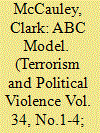

|
|
|
|
|
| Summary/Abstract |
In this commentary, I compare the ABC model of radicalization with the Two Pyramids model of radicalization. Both models distinguish radicalization of opinion from radicalization of action. Beyond this agreement are questions about the concepts deployed in advancing the ABC model and research issues relating to applications of the two models. I conclude with an optimistic assessment of recent progress in research on terrorism, including the suggestion that deradicalization of action may be forwarded by giving up on deradicalization of opinion.
|
|
|
|
|
|
|
|
|
|
|
|
|
|
|
|
| 2 |
ID:
188039


|
|
|
|
|
| Summary/Abstract |
This article responds to Clark McCauley’s commentary on our Attitudes-Behaviors Corrective (ABC) Model of Violent Extremism, in which he contrasts our framework with his own two pyramids model (developed with Sophia Moskalenko). In particular, we focus on further distinguishing between the “core” and “optional extra” elements of our ABC model, elaborating on how our interpretation deals with individuals who seemingly become involved in violence in the interests of the group, “unpacking” the concept of ideology through our ABC lens, and providing recommendations on how to measure attitudes and behaviors in a context specific manner.
|
|
|
|
|
|
|
|
|
|
|
|
|
|
|
|
| 3 |
ID:
188023


|
|
|
|
|
| Summary/Abstract |
The dominant academic narrative portrays British Muslim communities as alienated by counter-terrorism policies and consequently reluctant to cooperate with authorities by taking action against Islamist extremism. This article reassesses and nuances the “alienation narrative” with the use of unique data from three robust surveys of British Muslims. It finds that although a minority shows signs of alienation, most British Muslims are satisfied with and trust counter-terrorism policies as well as the government and the police. The level of willingness to take action against Islamist extremism is also high. The study confirms that aspects of alienation correlate with reduced willingness to take action against Islamist extremism, although they do not necessarily lead to disengagement.
|
|
|
|
|
|
|
|
|
|
|
|
|
|
|
|
| 4 |
ID:
188037
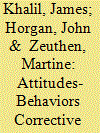

|
|
|
|
|
| Summary/Abstract |
Progress in understanding and responding to terrorism and violent extremism has continued to stall in part because we often fail to adequately conceptualize the problem. Perhaps most notably, much of our terminology (for instance, “radicalization”) and many variants of our existing models and analogies (including conveyor belts, staircases and pyramids) conflate sympathy for this violence with involvement in its creation. As its name suggests, the Attitudes-Behaviors Corrective (ABC) model seeks to overcome this issue by placing this key disconnect between attitudes and behaviors at its core. In this paper, we first present the key elements of our model, which include a graphic representation of this disconnect and a classification system of the drivers of violent extremism. The former enables us to track the trajectories of individuals in relation to both their attitudes and behaviors, while the latter helps ensure that we consider all potential explanations for these movements. We then adapt these elements to focus on exit from violence, applying the dual concepts of disengagement and deradicalization. Finally, we conclude with a section that aims to provide the research community and those tasked with preventing and countering violent extremism with practical benefits from the ABC model.
|
|
|
|
|
|
|
|
|
|
|
|
|
|
|
|
| 5 |
ID:
188036
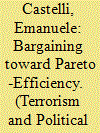

|
|
|
|
|
| Summary/Abstract |
Building on bargaining theory literature, I outline an original rationalist model that takes in consideration the problem of relative gains to explain why bargaining failures may lead to escalation in an open civil war and when negotiations in civil disputes are more likely to lead to Pareto-efficient solutions. I apply the model to the South Tyrol case, a relatively unknown identity-based dispute that emerged in Italy in the aftermath of the Second World War and was defused before it could produce a real escalation in violence. I show that direct and indirect compensations may help to overcome the problem of issue indivisibility, and that third-party intervention in domestic disputes may work as a functional substitute for simultaneity between the agreement and the enforcement phase.
|
|
|
|
|
|
|
|
|
|
|
|
|
|
|
|
| 6 |
ID:
188031


|
|
|
|
|
| Summary/Abstract |
Globally, the spread and use of suicide bombing attacks have become a regular occurrence. Suicide terrorism literature focuses primarily on conventional suicide bombing attacks. However, a growing trend has been observed in the adoption of complex suicide attacks. Using Al-Shabaab as a case study, this paper investigates the phenomenon of complex suicide attacks. We explore the tactical differences of complex suicide attacks vis-à-vis simple attacks in terms of its target goal, discriminative lethality, and delivery method. The paper relies on a uniquely constructed dataset of the group’s suicide operations, employing a variety of data collection techniques. The findings reveal that, inter alia, complex suicide attacks reduce civilian casualties compared to simple suicide attacks. Contrary to the group’s intent and official guidelines to target foreign entities; findings illustrate that domestic targets bear the brunt of most complex suicide attacks. These findings have the potential to contribute to counter-terrorism strategies and be adopted by concerned states in order to effectively protect significant loss of lives and destruction of property resulting from suicide terrorism.
|
|
|
|
|
|
|
|
|
|
|
|
|
|
|
|
| 7 |
ID:
188027
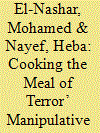

|
|
|
|
|
| Summary/Abstract |
This paper linguistically investigates terrorist discursive strategies designed to manipulate recipients’ minds into accepting, even embracing, certain ideologies. Though extensive research has been done on manipulative discourse used by journalists and politicians, examining the same discourse used by terrorists received comparatively scant attention. Under Critical Discourse Analysis, we employ a framework of analysis of ISIS discursive tools of manipulation, drawing on Reisigl and Wodak’s (2009) and Wodak’s (2011) discursive strategies, qualitatively and quantitatively analyzing (17) ISIS statements released between 2014 and 2016. We explore the discursive tools ISIS has characteristically used to manipulate its audience and legitimate and defend its actions. The aim is that once terrorist narrative is dissected from a different approach, such effort will be helpful in creating counter-narratives meant to reduce terrorism and vitiate its arguments. Emphasis will be laid on covert vs. overt manipulation, metaphorical dehumanization and metonymic depersonalization. We find that the data contained manipulative tools such as Captatio benevolentiae and volitive modality that are employed to project a positive image about ISIS.
|
|
|
|
|
|
|
|
|
|
|
|
|
|
|
|
| 8 |
ID:
188048
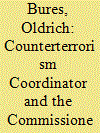

|
|
|
|
|
| Summary/Abstract |
Both national and EU officials have repeatedly emphasized the need for a comprehensive and strongly coordinated EU counterterrorism policy in order to bring together the disparate measures taken by the member states, avoid duplication of action, involve uninterested member states, and to present the EU as a coherent counterterrorism actor. To address these concerns, the EU member states agreed to create the position of an EU Counterterrorism Coordinator in 2005, only to be followed in 2016 with the position of an EU Commissioner for Security Union. A question therefore arises as to whether the EU needs two counterterrorism coordinators. This article addresses this question by utilizing Pierre Bourdieu’s concepts of field, capital, doxa, and habitus and argues that there is no apparent rationale for the coexistence of two EU Counterterrorism Coordinators with an overlapping mandate and minimal material, similar cultural and vastly disparate symbolic capital.
|
|
|
|
|
|
|
|
|
|
|
|
|
|
|
|
| 9 |
ID:
188047
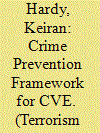

|
|
|
|
|
| Summary/Abstract |
CVE is a diverse policy space involving efforts to build cohesive communities, support young people who are vulnerable to radicalization, and deradicalize convicted terrorism offenders. Recently, the public health model of disease prevention has become an influential framework for understanding these diverse components. In this paper, I argue that crime prevention should be preferred as a conceptual framework for CVE. I offer a criminological framework encompassing situational prevention, developmental prevention, community crime prevention, third-party policing and procedural justice policing. I develop these concepts into an agenda for crime prevention research in CVE. I also briefly outline some of the lessons that the evidence base from criminology may provide when designing CVE programs and policy.
|
|
|
|
|
|
|
|
|
|
|
|
|
|
|
|
| 10 |
ID:
188044


|
|
|
|
|
| Summary/Abstract |
Research suggests that lone-actor terrorists and mass murderers may be better conceptualized as lone-actor grievance-fueled violence (LAGFV) offenders, rather than as distinct types. The present study sought to examine the extent to which these offenders could (or could not) be disaggregated along dimensions relevant to the threat assessment of both. Drawing on a Risk Analysis Framework (RAF), the offending process was theorized as interactions among propensity, situation, preparatory, leakage and network indicators. We analyzed a dataset of 183 U.S. offenders, including sixty-eight lone-actor terrorists and 115 solo mass murderers. Cluster analysis identified profiles within each of the components: propensity (stable, criminal, unstable), situation (low stress, high stress (social), high stress (interpersonal)), preparatory (fixated, novel aggression, equipped, clandestine, predatory, preparatory), leakage (high leakage, low leakage), and network (lone, associated, connected). Bi-variate analysis examined the extent to which the profiles classified offenders previously labeled as lone-actor terrorists or mass murderers. The results suggest that while significant differences may exist at the periphery of these dimensions, offenders previously classified as lone-actor terrorists or mass murderers occupy a noteworthy shared space. Moreover, no profile classifies a single “type” of offender exclusively. Lastly, we propose a dynamic, interactional model of LAGFV and discuss the implications of these findings for the threat assessment and management of LAGFV offenders.
|
|
|
|
|
|
|
|
|
|
|
|
|
|
|
|
| 11 |
ID:
188055


|
|
|
|
|
| Summary/Abstract |
Many nonstate military organizations provide a wide range of social services to civilians. The apparent contradiction between their use of violence and their provision of charity has been the subject of a great deal of research in the conflict studies literature. Two of the most common sets of arguments hold that such services are either a form of bribery aimed at controlling and isolating constituents and potential recruits, or an extension of the organization’s ideological commitments. Our findings, based on a new analysis of the BAAD dataset, demonstrate that neither explanation is correct. Rather, we find that the provision of social services represents a means of confronting and undermining the authority of the state. In this sense, the provision of social services represents an extension of the broader political goals of the nonstate armed groups providing them.
|
|
|
|
|
|
|
|
|
|
|
|
|
|
|
|
| 12 |
ID:
188043
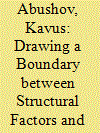

|
|
|
|
|
| Summary/Abstract |
This article focuses on the causes of ethnic civil wars, and argues that in order to develop a better understanding of their onset and intractability, one needs to distinguish different types of ethnic civil wars from each other. It first evaluates structural factors in the outbreak of ethnic conflict and then proceeds to discuss ideational factors and finally suggests a theoretic framework of understanding ethnic conflict based upon identity. It develops hypotheses that would allow to discern structuralist explanations from ideational ones and in this way contributes to the literature that tries to understand the causes of ethnic civil wars. To have a clear understanding of the suggested hypotheses, empirical evidence is provided from the post-Soviet space, namely conflicts such as Abkhazia, Crimea, Chechnya, Nagorno-Karabakh, and South Ossetia.
|
|
|
|
|
|
|
|
|
|
|
|
|
|
|
|
| 13 |
ID:
188041


|
|
|
|
|
| Summary/Abstract |
The past three decades have seen an increase in both domestic terrorist attacks and loans issued by the International Monetary Fund (IMF). In this study, we investigate the connection between IMF loan arrangements and domestic terrorism. We find that countries under IMF loans tend to observe fewer domestic terrorist incidents, especially when the borrowers are democracies. We contend that, while the IMF pressures borrower countries to prevent money laundering and combat the financing of terrorism, this effect is most pronounced in democracies, whose large selectorates incentivize the provision of public goods in a manner that works to reduce domestic terrorism. Our research shows how domestic and international institutions together can possibly help lower incidents of domestic terrorism.
|
|
|
|
|
|
|
|
|
|
|
|
|
|
|
|
| 14 |
ID:
188032


|
|
|
|
|
| Summary/Abstract |
The distinction between hate crime and terrorism is a contentious legal issue that impacts how respective crimes are labeled and prosecuted. Using a legal content analysis, this study examines what central legal elements comprise hate crimes and terrorism, respectively, for each state to discern their legal differences. The analysis along with exegesis of terrorism and hate crime definitions enumerated in state law demonstrates that these crimes are too similar to be different legal constructs, given their definitional elements and real-world applications. The study concludes that these “crimes” need to either be eliminated from criminal law or altered so as to make the adjudication of so-called extremism more parsimonious, equitable, and consistent. Recommendations are proffered on how this can be accomplished.
|
|
|
|
|
|
|
|
|
|
|
|
|
|
|
|
| 15 |
ID:
188053


|
|
|
|
|
| Summary/Abstract |
This study quantitatively and qualitatively analyzes the impact and effectiveness of Turkey’s deterrence-oriented incapacitation effort throughout Turkey’s PKK conflict (1984–2018). By employing vector autoregressive (VAR) analysis, this study quantitatively finds that incapacitation did not reduce PKK violence over the long term and yielded a short-term counterproductive effect. Descriptive analysis asserts that while incapacitation had important mid-term deterring effects, it did not have any sustainable mitigation on the PKK insurrection. This is because, as this study argues, these deterrent impacts were not strategically converted into political gains/results. Considering the latest phase of the conflict, in which Turkey’s intra-state strife has become increasingly regionalized and lately internationalized in military and political terms with the emergence of the Syrian civil war, particularly the rise of the People’s Protection Units (YPG), this study claims that the sole application of an incapacitation-oriented eliminationist approach has become less relevant and less effective. The study suggests that deterrence should be considered within the strategic tit-for-tat game to force/compel the non-state actor to make the conflict more manageable by transforming it in a strategic way, in which strategy of deterrence is to be attached to visionary, long-term, and viable grand strategic political end-states and to be considered within the grand bargaining game.
|
|
|
|
|
|
|
|
|
|
|
|
|
|
|
|
| 16 |
ID:
188035
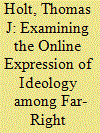

|
|
|
|
|
| Summary/Abstract |
Over the last decade, there has been an increased focus among researchers on the role of the Internet among actors and groups across the political and ideological spectrum. There has been particular emphasis on the ways that far-right extremists utilize forums and social media to express ideological beliefs through sites affiliated with real-world extremist groups and unaffiliated websites. The majority of research has used qualitative assessments or quantitative analyses of keywords to assess the extent of specific messages. Few have considered the breadth of extremist ideologies expressed among participants so as to quantify the proportion of beliefs espoused by participants. This study addressed this gap in the literature through a content analysis of over 18,000 posts from eight far-right extremist forums operating online. The findings demonstrated that the most prevalent ideological sentiments expressed in users’ posts involved anti-minority comments, though they represent a small proportion of all posts made in the sample. Additionally, users expressed associations to far-right extremist ideologies through their usernames, signatures, and images associated with their accounts. The implications of this analysis for policy and practice to disrupt extremist movements were discussed in detail.
|
|
|
|
|
|
|
|
|
|
|
|
|
|
|
|
| 17 |
ID:
188034


|
|
|
|
|
| Summary/Abstract |
In seeking to overthrow, reform, or separate from an existing political system, both violent and nonviolent resistance organizations emerge. A common finding shows that democracies face violent resistance more so than autocracies. Studied less remains the pattern of organizations using nonviolence in efforts to topple autocratic regimes. What explains these trends in conjunction with one another? I put forth a theory contending that exclusionary politics frames the organizational use of violence and nonviolence in resistance campaigns. To test hypotheses, I analyze an original dataset of over 500 resistance organizations (1940–2014). I complement the large-n tests by reviewing resistance organizations that formed amid Lebanon’s Civil War (1975–1990) and Cedar Revolution (2005) using field methods, qualitative contextualization, and process tracing. The results reveal that the relationship between the target political system and the degree of inclusion of a resistance organization’s constituent identity group helps explain the adoption of violent strategies.
|
|
|
|
|
|
|
|
|
|
|
|
|
|
|
|
| 18 |
ID:
188033
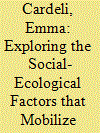

|
|
|
|
|
| Summary/Abstract |
This article applies the social-ecological model to children’s mobilization into two violent groups—Central American gangs and terrorist organizations. While these two groups clearly differ in important ways, there are contextual similarities that frame a child’s involvement in each. For example, both flourish in low-resource settings where governmental structures may have been weakened or disrupted. Does it follow, therefore, that similar processes are at play in relation to children engaging in violent groups? This paper seeks to answer this question, reviewing available literature on the social-ecological factors that promote engagement in each group. Points of convergence and divergence between the groups are identified, and implications for prevention and intervention efforts are explored.
|
|
|
|
|
|
|
|
|
|
|
|
|
|
|
|
| 19 |
ID:
188029
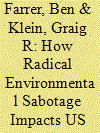

|
|
|
|
|
| Summary/Abstract |
In this paper we examine the impact of forceful or violent environmental sabotage (FVES) on U.S. elections. We argue that voters see ideological similarities between groups that engage in FVES and other nonviolent environmental organizations, like the Green Party. This means that when an environmentalist organization engages in FVES, it has a negative impact on voter attitudes toward all environmental organizations. Moreover, this negative impact will be stronger if environmentalists had previously made electoral progress, and so they cannot use the excuse that democratic methods had failed and they were forced to turn to FVES. We demonstrate this by showing that when FVES occurs, Green Party candidates tend to win a lower share of the vote in the next election. However, this effect is conditional on the prior electoral history of the Green Party. If the Green Party has a poor electoral record, then sabotage has little effect, but if the Green Party has a better electoral record, then voters are less forgiving of sabotage. We find no evidence that FVES effects Republican or Democratic vote shares. We conclude that different organizations within the same social movement are connected in ways that impact electoral outcomes.
|
|
|
|
|
|
|
|
|
|
|
|
|
|
|
|
| 20 |
ID:
188049
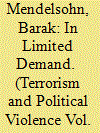

|
|
|
|
|
| Summary/Abstract |
The wars in Syria and Iraq attracted about 45,000 individuals from outside the arenas. Most joined the Islamic State, but interestingly, other prominent armed groups showed less interest in foreign volunteers. This paper introduces the Demand for Foreign Volunteers Theory (DFVT) to explain the diverging choices Jabhat al-Nusra, Ahrar al-Sham, and the People’s Protection Units made. The theory links four variables that shape groups’ positions: political considerations, operational needs, organizational capacity, and ideational fit. Both operational and political considerations emphasize the motivation for using foreign volunteers, though the two are not equally important; when they conflict, political considerations take priority. Organizational capacity, on the other hand, determines a group’s ability to translate need into action, serving as a necessary—but insufficient—condition for foreign mobilization. Finally, ideational factors, specifically a group’s identity and ideology, determine the pool of potential recruits. The case studies show that political considerations made all three actors cautious about recruiting foreign fighters, though these considerations differed between groups. Ultimately, despite the availability of sufficient organizational capacity, all groups found it risky and even undesirable
|
|
|
|
|
|
|
|
|
|
|
|
|
|
|
|
|
|
|
|
|